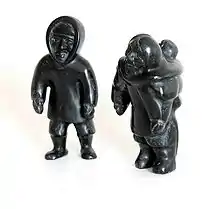Qaunak Mikkigak
Qaunak Mikkigak (born November 15, 1932, also known as Qaunaq Mikkigak or Haunak Mikkigak) is an Inuk throat singer, storyteller, drawer, sculptor, jeweler and writer from Cape Dorset, Nunavut, Canada.[1] She co-authored the children's books The Legend of the Fog[2] and Grandmother Ptarmigan[3] based on traditional Inuit stories. She was featured in the book Inuit women artists: voices from Cape Dorset[4] for her artwork and in Cape Dorset Sculpture.[5] She currently lives in Cape Dorset, Nunavut, Canada.

Family
Qaunak Mikkigak is the daughter of Mary Kudjuakjuk, a graphic artist, and Pitseolak. She has a younger brother and ties to four formerly adoptive siblings. She is the wife of Oqutaq Mikkigak (also transliterated as Ohotaq Mikkigak or Ohuqtaq Mikkigak), fellow drawer and sculptor.[5] She has eight children, one of her own and seven adoptive children.[4]
Early life
Born November 15, 1932 in the camp, Nuvujuak (also known as Nunavut). She has lived her entire life in the area of and around Cape Dorset. When Qaunak was a very young child (about 3 or 4) she was temporarily adopted by a family in another camp (reasons for this adoption are unknown). During this time she was mistreated and beaten by her adoptive parents. She found refuge with her eldest adopted brother and his wife, who would feed her when they were alone. After a visit from her father, she was later returned to her family in the spring.[4]
After being returned home Qaunak enjoyed learning the traditional Inuit ways of life from her mother Mary Kudjuakjuk. Mary couldn't move around a lot due to a heart condition and so Qaunak did most of the work, such as collecting firewood, fetching water, preparing seal blubber, emptying the qurvik, cleaning the igloo floor, and chewing and sewing skins to make the family's clothing.[4]
Qaunak's father died when she was about eight or ten years old. Later her mother remarried a man named Quppapik and moved to Churchill, Manitoba for employment. Qaunak remained behind to continue living in Nuvujuak.[4]
Marriage
Qaunak married Ohotaq Mikkigak, and they lived the traditional Inuit lifestyle in Nuvujuak together. When Qaunak's mother and stepfather returned to Cape Dorset for Quppapik to become a custodian at the school, the Mikkigak family also moved into the settlement to enroll their two young children into the school. Later both she and her husband followed in Quppapik's footsteps and became employed as custodians. Both Qaunak and her husband produce their work for their own enjoyment, and Qaunak takes pride in helping to support her family.
Artistic biography
Before her father's death, Qaunak remembers watching him and the other men of Nuvujuak carving ivory and stone into small figures to sell to the Hudson's Bay Company. During this time she also began creating carvings of her own, but kept them hidden because only men were carving at the time. As such, she is considered one of the first Inuit women carvers.[4] After her father's death she began to carve more openly. Qaunak started with making soapstone heads for dolls, later creating qulliit and then geese. She makes her carvings using an axe and file, never electric tools.[4]
Qaunak has created work in several mediums, including; jewelry, drawing, and sewing. She is best known for her naturalistic sculptures and carving. The themes and imagery present in her work include traditional folk tales, animals, angakuit (shamans), and other figures.[4] Qaunak is quoted saying,
I like to carve human figures the most, especially those of women. It's challenging to try and make their faces feminine-looking...
— [4]
Qaunak Mikkigak's work has been in many collections, shows, and galleries. These include:
Prints in the annual Cape Dorset print collections, 1980, 1981, and 1986.[4]
Group Shows; Eskimo_Sculpture, Eskimo Prints and Paintings of Norval Morrisseau, (Art Association of Newport, Rhode Island[6] 1968) Debut- Cape Dorset Jewelry, (Canadian Guild of Crafts Quebec, Montreal 1976) Things That Make Us Beautiful/ Nos Parures,(Department of Indian Affairs and Northern Development, Ottawa 1977-78) and Northern Exposure: Inuit Images of Travel,(Burnaby Art Gallery, British Columbia 1986).[4]
Private and Public Collections: Art Gallery of Ontario; the Canadian Museum of Civilization; the Inuit Cultural Institute, Rankin Inlet; the Laurentian University Museum and Arts Centre, Sudbury; the National Gallery of Canada; the Prince of Wales Northern Heritage Centre, Yellowknife; and the Winnipeg Art Gallery.[4]
Music
Qaunak Mikkigak is known also for her traditional Inuit throat singing. She has travelled throughout Canada and internationally to perform.[4]
Books
The Legend of the Fog
The Legend of the Fog is the story of a boy making his way across the tundra when he encounters a giant who wishes to eat him. In his escape from the giant, the boy releases the first fog into the world.[2]
Grandmother Ptarmigan
Grandmother Ptarmigan explains why ptarmigans make the calls that they do and why young ptarmigans fly early in life. This is done through the scenario of a ptarmigan telling a bedtime story to her grandchildren.[3]
References
- "Qaunaq Mikkigak". www.gallery.ca. Retrieved 2017-03-11.
- Mikkigak, Qaunaq (2012-04-17). Legend of the Fog. Inhabit Media Incorporated. ISBN 9781927095058.
- Mikkigak, Qaunaq; Schwartz, Joanne (2013). Grandmother Ptarmigan. Inhabit Media Inc.
- Leroux, Odette; Jackson, Marion E; Freeman, Minnie Aodla; Canadian Museum of Civilization (1994-01-01). Inuit women artists: voices from Cape Dorset. Vancouver; Hull, Quebec; Seattle: Douglas & McIntyre ; Canadian Museum of Civilization ; University of Washington Press. pp. 112–117. ISBN 0295973897.
- Norton, Derek; Reading, Nigel (April 2005). Cape Dorset Sculpture. Douglas & McIntyre.
- Art Association of Newport, Rhode Island